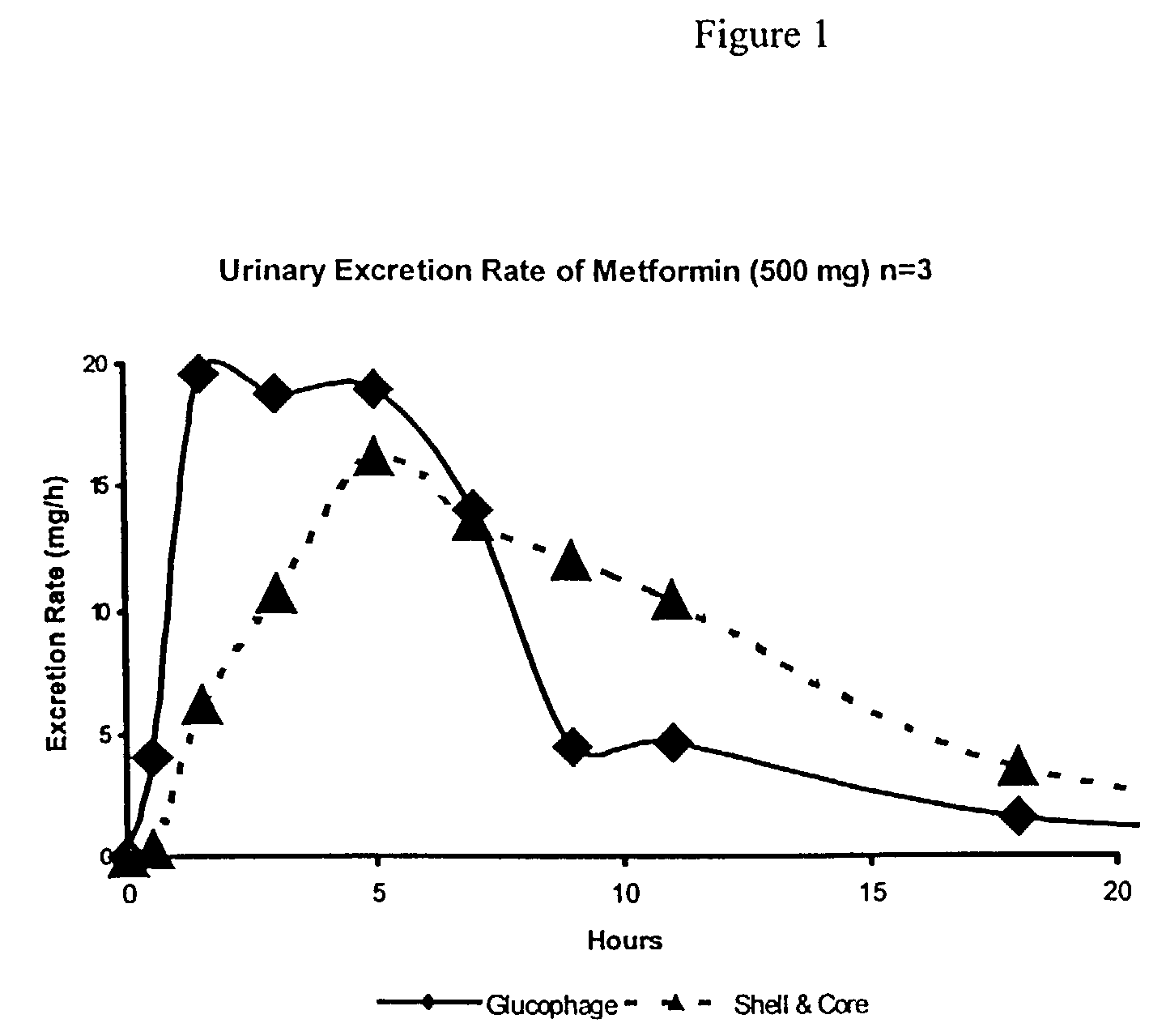Shell-and-core dosage form approaching zero-order drug release
a dosage form and drug technology, applied in the field of formulations of drugs, can solve the problems of rapid decline, transient overdose, long period of underdosing, etc., and achieve the effect of sufficient thickness and strength
- Summary
- Abstract
- Description
- Claims
- Application Information
AI Technical Summary
Benefits of technology
Problems solved by technology
Method used
Image
Examples
example 1
Compressed Core-and-Shell Tablets of Metformin Hydrochloride
[0099]This example illustrates the preparation and release rate behavior of a tablet in accordance with the invention, with a 600-mg core and a 200-mg shell, both of poly(ethylene oxide) and additionally containing metformin hydrochloride in the core only, in a quantity amounting to 62.5% by weight of the core. The term “compressed core-and-shell tablet” is used herein to denote a tablet formed by first compressing the core in a tablet press from a powdered mixture and then using a suitable tablet press to compress another powdered mixture over the core to form the shell. This is distinct from methods of forming a capsule.
[0100]To prepare the core, a powder blend was prepared by mixing together metformin hydrochloride (9.374 parts by weight), POLYOX 301 (molecular weight approximately 4,000,000, 5.478 parts by weight), and magnesium stearate (0.151 parts by weight). A 600-mg portion of the mixture was placed on a Carver Aut...
example 2
Compressed Core-and-Shell Tablets of Metformin Hydrochloride
[0103]This example is a further illustration of the preparation and release rate characteristics of a metformin hydrochloride tablet in accordance with the invention. The procedure of Example 1 was repeated, using nearly identical quantities of materials, except that the poly(ethylene oxide) used as the core matrix was POLYOX Coagulant (molecular weight approximately 5,000,000) rather than POLYOX 301 (molecular weight approximately 4,000,000). The release rate results are listed in Table II, which shows that the release rate again approached zero order.
[0104]
TABLE IIMetformin Hydrochloride Release StudyAmount ReleasedTime from Start of Test(Percentage of(hours)Total in Core)217.3437.4655.3869.5
example 3
Compressed Core-and-Shell Tablets of Metformin Hydrochloride
[0105]This example is a further illustration of the preparation and release rate characteristics of a metformin hydrochloride tablet in accordance with the invention, similar to that of Examples 1 and 2. In this example, however, metformin hydrochloride constituted 83.3% by weight of the core (and present only in the core, as in Examples 1 and 2), and the higher molecular weight poly(ethylene oxide) (POLYOX 303) was used for the core while the lower molecular weight poly(ethylene oxide) (POLYOX 301) was used for the shell. Otherwise, the procedures were essentially the same as those of Examples 1 and 2, except that the die for the outer shell measured 0.3125×0.75 inch (0.79×1.90 cm). The results are listed in Table III, which shows that the release rate again approached zero order.
[0106]
TABLE IIIMetformin Hydrochloride Release StudyAmount ReleasedTime from Start of Test(Percentage of(hours)Total in Core)221.5445.6665.4878.2...
PUM
| Property | Measurement | Unit |
|---|---|---|
| Weight | aaaaa | aaaaa |
| Weight | aaaaa | aaaaa |
| Weight | aaaaa | aaaaa |
Abstract
Description
Claims
Application Information
 Login to View More
Login to View More - R&D
- Intellectual Property
- Life Sciences
- Materials
- Tech Scout
- Unparalleled Data Quality
- Higher Quality Content
- 60% Fewer Hallucinations
Browse by: Latest US Patents, China's latest patents, Technical Efficacy Thesaurus, Application Domain, Technology Topic, Popular Technical Reports.
© 2025 PatSnap. All rights reserved.Legal|Privacy policy|Modern Slavery Act Transparency Statement|Sitemap|About US| Contact US: help@patsnap.com

